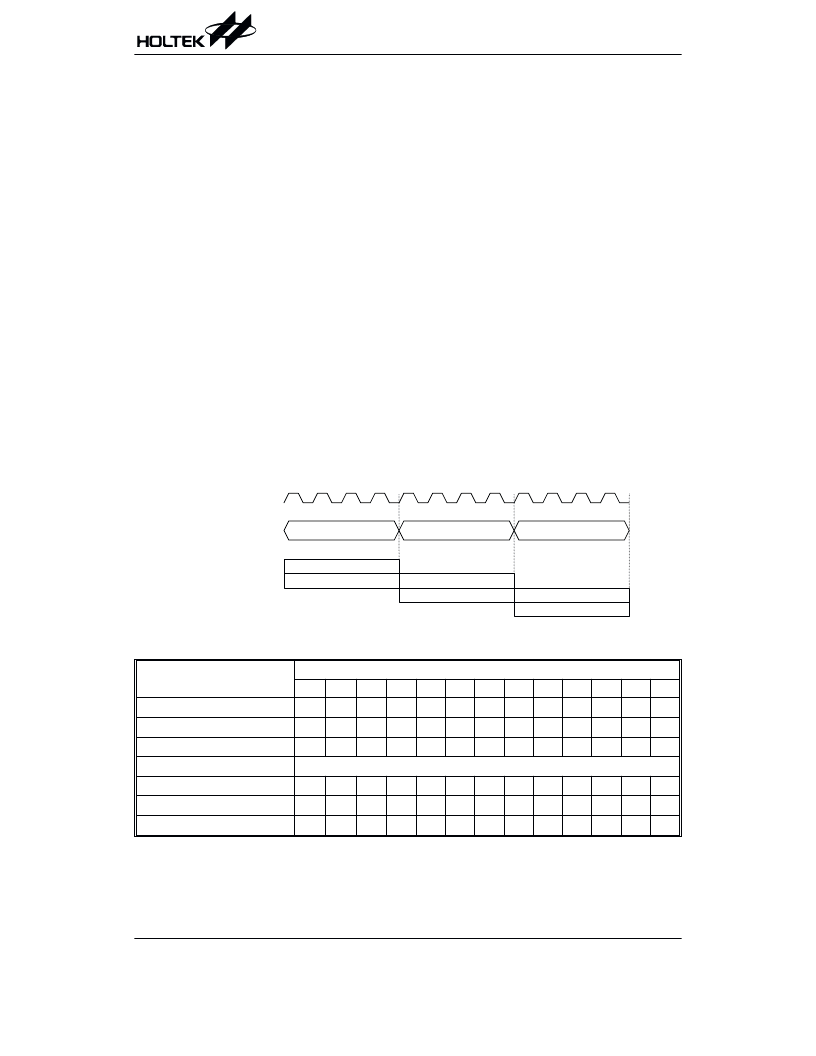- 您現(xiàn)在的位置:買(mǎi)賣(mài)IC網(wǎng) > PDF目錄371900 > HT36A0(48DIP) Microcontroller PDF資料下載
參數(shù)資料
| 型號(hào): | HT36A0(48DIP) |
| 英文描述: | Microcontroller |
| 中文描述: | 微控制器 |
| 文件頁(yè)數(shù): | 6/21頁(yè) |
| 文件大小: | 229K |
| 代理商: | HT36A0(48DIP) |
第1頁(yè)第2頁(yè)第3頁(yè)第4頁(yè)第5頁(yè)當(dāng)前第6頁(yè)第7頁(yè)第8頁(yè)第9頁(yè)第10頁(yè)第11頁(yè)第12頁(yè)第13頁(yè)第14頁(yè)第15頁(yè)第16頁(yè)第17頁(yè)第18頁(yè)第19頁(yè)第20頁(yè)第21頁(yè)

HT36A0
Rev. 1.00
6
September 3, 2002
Function Description
Execution flow
The system clock for the HT36A0 is derived from either
a crystal or an RC oscillator. The oscillator frequency di-
vided by 2 is the system clock for the MCU and it is inter-
nally divided into four non-overlapping clocks. One
instruction cycle consists of four system clock cycles.
Instruction fetching and execution are pipelined in such
a way that a fetch takes one instruction cycle while de-
coding and execution takes the next instruction cycle.
However, the pipelining scheme causes each instruc-
tion to effectively execute in one cycle. If an instruction
changes the program counter, two cycles are required
to complete the instruction.
Program counter
PC
The 13-bit program counter (PC) controls the sequence
in which the instructions stored in program ROM are ex-
ecuted and its contents specify a maximum of 8192 ad-
dresses for each bank.
After accessing a program memory word to fetch an in-
struction code, the contents of the program counter are
incremented by one. The program counter then points
to the memory word containing the next instruction
code.
When executing a jump instruction, conditional skip ex-
ecution, loading PCL register, subroutine call, initial re-
set, internal interrupt, external interrupt or return from
subroutine, the PC manipulates the program transfer by
loading the address corresponding to each instruction.
Theconditionalskipisactivatedbyinstruction.Oncethe
condition is met, the next instruction, fetched during the
current instruction execution, is discarded and a dummy
cyclereplacesittoretrievetheproperinstruction.Other-
wise proceed with the next instruction.
The lower byte of the program counter (PCL) is a read-
able and writeable register (06H). Moving data into the
PCL performs a short jump. The destination will be
within 256 locations.
Once a control transfer takes place, an additional
dummy cycle is required.
Program ROM
HT36A0 provides 16 address lines WA[15:0] to read the
Program ROM which is up to 1M bits, and is commonly
used for the wavetable voice codes and the program
memory. It provides two address types, one type is for
program ROM, which is addressed by a bank pointer
PF2~0 and a 13-bit program counter PC 12~0; and the
'
'
' !
'
'
'
' !
'
'
'
' !
'
(
6
. 1 + " ' . ,
/
# ;
6
. 1 + " ' . ,
/
(
6
. 1 + " ' . ,
<
/
# ;
6
. 1 + " ' . ,
/
(
6
. 1 + " ' . ,
<
/
# ;
6
. 1 + " ' . ,
<
/
<
<
" 7
= .
3 6 : . 3 0 .
, " 7
= .
3 6 :
/
Execution flow
Mode
Program Counter
*12
*11
*10
*9
*8
*7
*6
*5
*4
*3
*2
*1
*0
Initial Reset
0
0
0
0
0
0
0
0
0
0
0
0
0
Timer/event Counter 0 Overflow
0
0
0
0
0
0
0
0
0
1
0
0
0
Timer/event Counter 1 Overflow
0
0
0
0
0
0
0
0
0
1
1
0
0
Skip
PC+2
Loading PCL
*12
*11
*10
*9
*8
@7
@6
@5
@4
@3
@2
@1
@0
Jump, Call Branch
#12
#11
#10
#9
#8
#7
#6
#5
#4
#3
#2
#1
#0
Return From Subroutine
S12
S11
S10
S9
S8
S7
S6
S5
S4
S3
S2
S1
S0
Program counter
Note:
*12~*0: Bits of Program Counter
@7~@0: Bits of PCL
#12~#0: Bits of Instruction Code
S12~S0: Bits of Stack Register
@7~@0: Bits of PCL
相關(guān)PDF資料 |
PDF描述 |
|---|---|
| HT3820(16DIP) | Sound Generator Circuit |
| HT3820(16SOP) | Sound Generator Circuit |
| HT3820A | Sound Generator Circuit |
| HT3820A(TO92A) | Analog IC |
| HT3820B | Sound Generator Circuit |
相關(guān)代理商/技術(shù)參數(shù) |
參數(shù)描述 |
|---|---|
| HT36A1 | 制造商:HOLTEK 制造商全稱(chēng):Holtek Semiconductor Inc 功能描述:Music Synthesizer 8-Bit MCU |
| HT36A2 | 制造商:HOLTEK 制造商全稱(chēng):Holtek Semiconductor Inc 功能描述:8-Bit Music Synthesizer MCU |
| HT36A3 | 制造商:HOLTEK 制造商全稱(chēng):Holtek Semiconductor Inc 功能描述:8-Bit Music Synthesizer MCU |
| HT36A4 | 制造商:HOLTEK 制造商全稱(chēng):Holtek Semiconductor Inc 功能描述:Music Synthesizer 8-Bit MCU |
| HT36A4_07 | 制造商:HOLTEK 制造商全稱(chēng):Holtek Semiconductor Inc 功能描述:Music Synthesizer 8-Bit MCU |
發(fā)布緊急采購(gòu),3分鐘左右您將得到回復(fù)。